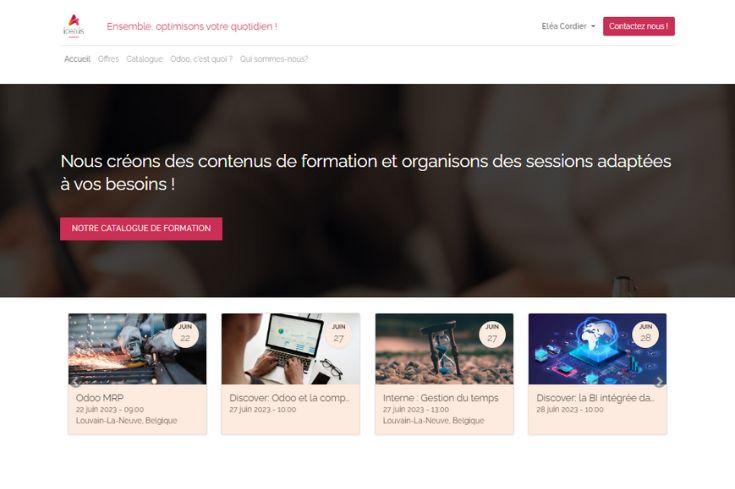Discover how we can help you to support your sales hunting processes.
Hunting in commercial practices involves identifying and targeting potential customers who may have an interest in the products or services offered by a company. This usually requires conducting research, prospecting, and reaching out to individuals or organizations that fit the target market.
The hunting process may involve various strategies and techniques, such as cold calling, networking, attending industry events, using social media platforms for outreach, or conducting targeted advertising campaigns. The goal is to initiate contact with potential customers, present the company's offerings, and persuade them to consider purchasing or engaging with the business. We can help you to integrate these processes and activites in Odoo.
How can we support you ?
1) Define your Master Data
- We recommend that you first define your sales teams: their members, their scope, their targets and their financial objectives. Odoo CRM allows you to manage this.
- We recommend that you also define your products, product categories and commercial tags. This practice will enable you to sort your leads and opportunities in order to calibrate your efforts.
2) Define and pilot your campaigns
Odoo lets you manage your sales campaigns. Depending on your sector of activity, you can use cold calling, although current best practice is to use inbound marketing.
Inbound marketing is a marketing methodology that focuses on attracting customers through valuable content and experiences, rather than using traditional interruptive advertising techniques. It revolves around creating and sharing content that is relevant, informative, and engaging to draw potential customers to your brand and establish a lasting relationship with them. The ultimate aim is for your target to call you to arrange a concrete meeting and ask you for an offer.
Let's take an example and see how it can be managed with Odoo. You are a company that sells clothes. You want to promote your new range, which is very eco-friendly and complies with the new ESG standards. We recommend that you create a campaign called ESG and carry out activities to reach your target audience. The same content that you deploy on your different media. Another article on our website (FARMING) explains all these possibilities in detail: emailing, events, social networks, sms, blog website, phone calls, whatsapp, SEO optimisation and marketing automation. We can aslo name this marketing practise: multi-channel marketing. Odoo can cover that.
- We recommend that you define your potential campaigns and medium (= method of delivery such as email or linkedin) in Odoo CRM.
When a lead or opportunity is generated, you can trace the source and the media. This allows you to measure your efforts and effectiveness.
3) Define your objectives & metrics
We recommend that you set objectives: by sales team, by person, by campaign, etc.
To this end, we suggest using Odoo's Spreadsheet solution: you can easily compare what you've achieved with your objectives at any time, via pivot tables updated in real time. In the example below, objectives have been set for each marketing campaign. The data in column C is entered manually, while the data in column B is realized and comes in real time from your CRM and your opportunities. You can easily build and track objectives. Odoo spreadsheet allows you to use over 200 Excel functions, such as a sum in the example below.
4) Manage your Sales Funnel
We recommande you to define your Sales Funnel: clearly define the stages of your sales funnel, from lead generation to closing a sale. Understand the actions and behaviors that typically occur at each stage. This allows you to track progress, identify bottlenecks, and make informed decisions to optimize the funnel.
Implement a lead qualification process to ensure that you focus your efforts on leads with the highest potential. Qualify leads based on criteria such as their needs, budget, authority to purchase, and timeline. This helps to prioritize resources and improves the efficiency of your sales team.
Odoo can cover these best practises.
5) Manage automated activities
To turn a target into an offer, you need to ensure that you follow certain good commercial practices. For example, we can indicate that a target must have experienced the various touch points below with you before signing:
- Have received references relevant to the target.
- Have attended at least one of your events.
- Have been on the phone with the same sales person at least 5 times.
- Have met a sales rep face-to-face at least 2x.
These touch points can be managed in Odoo as automated actions. When a lead or opportunity is created, Odoo will create actions and assign them to a team or a person according to your own criteria.
The Sales Manager can monitor these actions and ensure that his sales reps have completed all the touch points.
6) Measure your efforts
We recommand you to define KPI to follow in order to measure your efforts.
When managing a sales funnel, there are several key performance indicators (KPIs) that businesses commonly track to measure the effectiveness of their sales and marketing efforts. These KPIs can be configured in Odoo via the Dashboard and Spreadsheets applications.
Here are some important KPIs to consider:
- Conversion Rate: this KPI measures the percentage of leads that successfully move from one stage of the sales funnel to the next. It helps assess the overall efficiency of the funnel and identifies areas where improvements may be needed.
- Lead Velocity: lead velocity tracks the speed at which leads progress through the sales funnel. It measures the average time it takes for a lead to move from one stage to the next. Monitoring lead velocity helps identify bottlenecks and areas where leads tend to stall, allowing for targeted interventions to accelerate the sales process.
- Sales Cycle Length: this KPI measures the average length of time it takes to close a sale from the moment a lead enters the funnel. Shorter sales cycles are generally preferred as they indicate a more efficient and streamlined sales process.
- Win Rate: the win rate measures the percentage of leads or opportunities that are successfully converted into sales. It reflects the effectiveness of your sales efforts in closing deals. A higher win rate suggests that your sales team is successfully converting leads into customers.
- Average Deal Size: this KPI calculates the average value of each closed deal. It helps assess the financial impact of your sales efforts and provides insights into pricing strategies, upselling opportunities, and the overall revenue generated by the sales funnel.
- Sales Funnel Leakage: funnel leakage refers to the percentage of leads that are lost or drop out of the sales funnel at each stage. Tracking funnel leakage helps identify weak points and areas where leads are being lost, allowing for targeted improvements to plug the leaks and improve overall conversion rates.
- Return on Investment (ROI): ROI measures the financial return generated from your sales and marketing activities relative to the costs incurred. It assesses the efficiency and profitability of your sales funnel efforts.
7) Calculate commissions
When it comes to Hunting, active profiles are looking for commissions. Odoo allows you to manage commission plans. Calculations are automated, objective and transparent.

Our CRM references
Idealis Consulting has successfully manage CRM/ERP projects. We continually strive to satisfy our customers in a wide range of sectors.

CRM Training
Give yourself a unique opportunity to acquire the basic tools and skills needed to succeed in the world of customer relationship management using Odoo.


CRM | About Hunting